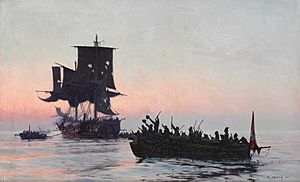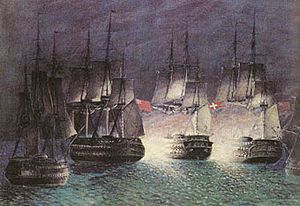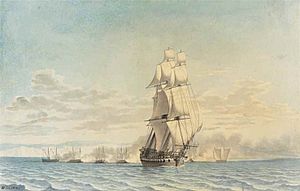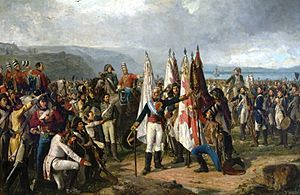Gunboat War facts for kids
Quick facts for kids The Gunboat War |
|||||||||
|---|---|---|---|---|---|---|---|---|---|
| Part of the English Wars and the Napoleonic Wars | |||||||||
 Danish privateers intercepting an enemy vessel during the Napoleonic Wars, a painting by Christian Mølsted depicting an unspecified engagement in the Gunboat War |
|||||||||
|
|||||||||
| Belligerents | |||||||||
|
Supported by: |
|
||||||||
The Gunboat War (also called Kanonbådskrigen in Danish and Kanonbåtkrigen in Norwegian) was a sea conflict between Denmark–Norway and Great Britain from 1807 to 1814. It happened during the larger Napoleonic Wars in Europe. The war got its name because Denmark used many small, fast gunboats to fight against the much bigger British Royal Navy. In Scandinavia, people see it as the final part of the English Wars, which started in 1801.
Contents
Why the War Started
The sea conflict between Britain and Denmark-Norway began with the First Battle of Copenhagen in 1801. At that time, Denmark-Norway wanted to stay neutral in the French Revolutionary Wars. They used their navy to protect their trade ships. However, British Admiral Horatio Nelson attacked the Danish capital.
Hostilities started again with the Second Battle of Copenhagen in 1807. The British attacked Copenhagen to stop Napoleon from getting control of the Danish-Norwegian fleet. They feared Napoleon would use these ships against Britain.
Denmark's New Gunboats
After the British took or destroyed many of Denmark-Norway's large ships in Copenhagen, the government decided to build many small gunboats. These boats were first designed by a Swede named Fredrik Henrik af Chapman.
Gunboats had several advantages:
- They were quick and cheap to build.
- They could be made all over the kingdom.
- They were easy to steer, especially in calm and shallow waters.
- They were small targets, making them hard to hit.
However, they also had weaknesses:
- They were fragile and could sink from one hit.
- They couldn't be used in rough seas.
- They were less effective against large warships.
Despite this, Denmark-Norway built over 200 gunboats. There were two main types:
- Shallop gunboats: These were larger, with a crew of 76 men. They had a powerful cannon at the front and another at the back.
- Barge gunboats: These were smaller, with a crew of 24 men. They had one main cannon.
Commodore Steen Andersen Bille was a key person behind Denmark-Norway's gunboat strategy after 1807. Here are the four main types of gunboats:
- Kanonchaluppen: These were the biggest gunboats. They had two 24-pounder cannons and four smaller howitzers. They carried 69 to 79 men.
- Kanonjollen: These were smaller gunboats. They had one 24-pounder cannon and two smaller howitzers. They carried 41 men.
- Morterchaluppen: These were larger boats armed with mortars. They had one 100-pounder mortar and two smaller howitzers. They carried 40 men.
- Morterbarkasserne: These were the smallest mortar boats. They had one mortar and 19 men. They were like regular small boats with a mortar added. They often leaked after firing a few mortar shells.
In 1808, ten special schooner-rigged gunboats were built in Norway. These were designed to handle the rougher waters of the Norwegian Sea.
The War in Action
In the first three years of the Gunboat War, these small boats often managed to capture enemy cargo ships and even British brigs (medium-sized sailing ships). However, they were not strong enough to defeat larger frigates or ships of the line.
The British controlled Danish waters for most of the war (1807–1814). When the weather was good, they regularly escorted large merchant ships through the Sound and the Great Belt. The British also captured many Danish privateers (private ships allowed to attack enemy shipping) and merchant vessels. They also made landings on Danish islands to get supplies like firewood, water, and livestock.
The Gunboat War also happened at the same time as the Anglo-Russian War. Because of this, the British extended their trade blockades to Russian waters. The British navy also raided places like Hasvik and Hammerfest in the Barents Sea, disrupting trade between Norway and Russia.
Early Battles (1807–1808)
On August 12, 1807, before the war was even officially declared, the British ship HMS Comus captured the Danish frigate Friderichsværn. The British had only one person wounded, while the Danes had 12 killed and 20 wounded. The British took the captured Danish ship into their own navy.
On August 23, the British ship HMS Prometheus used Congreve rockets against Danish gunboats, but it didn't do much damage. The British had more success on September 11 when the island of Heligoland surrendered to them. Heligoland later became a hub for smuggling and spying against Napoleon.
In India, British troops took over Danish areas at Tranquebar on February 13, 1808. On March 14, the British ship HMS Childers and the Danish sloop HDMS Lougen fought a battle that didn't have a clear winner. Childers lost two men killed and nine wounded.
On March 22, the British ships HMS Nassau and HMS Stately destroyed the last Danish ship of the line, HDMS Prinds Christian Frederik, in the Battle of Zealand Point. The British had some casualties, but the Danes lost 55 men killed and 88 wounded.

On April 22, British boats attacked a Danish-Norwegian convoy near The Skaw. This convoy was bringing supplies to Norway, which was facing shortages due to the British naval blockade. The British managed to capture several ships, losing five men wounded.
On May 15, the British frigate HMS Tartar tried to attack a Dutch frigate in Bergen harbor. The Dutch ship had already left, so the British tried to capture Danish ships instead. During the Battle of Alvøen, Tartar came under attack by a Danish schooner and five gunboats. Tartar's captain was killed, and twelve men were wounded before the ship escaped.
On May 24, the British cutter Swan fought a Danish vessel near Bornholm. The Danish ship exploded, and Swan had no casualties. However, fire from shore batteries forced Swan to leave without rescuing survivors.
On June 4, four Danish gunboats attacked and captured the British ship HMS Tickler after a four-hour fight. Tickler lost her captain and 14 other men killed. The Danes later used Tickler as a training ship.
The Danes also won on June 19 when the British brig HMS Seagull was attacked by the Danish brig HDMS Lougen and six gunboats. Seagull was badly damaged and surrendered, losing eight men killed and 20 wounded. Seagull sank soon after, but the Danes later recovered her for their navy.

On August 2, sixteen Danish gunboats captured the British ship HMS Tigress off Langeland. Tigress lost two men killed and eight wounded.
On October 20, 25 Danish gunboats and seven armed launches attacked the British ship HMS Africa in the Øresund. Africa lost nine men killed and 51 wounded. The Danes might have captured her if night had not fallen.
On December 5, the British ship HMS Proselyte was wrecked on Anholt Reef. The Danes had turned off the lighthouse on Anholt island, making the waters dangerous. All her crew were saved.
Middle Years (1809–1810)
On May 18, 1809, the British captured the island of Anholt. The Danish soldiers there surrendered after a short fight. The main goal was to restart the lighthouse on Anholt, which was important for British ships navigating the dangerous seas.

On June 9, a Danish and Norwegian fleet of gunboats attacked a British convoy of 70 merchant ships near Saltholm island. The Danes captured 12 or 13 merchant ships and one of the British escort ships, HMS Turbulent.
On August 10, the Danes also captured Template:HDMS Allart (1807) during the Battle of Saltholm. Allart, a former Danish ship, was chased by 15 Danish gunboats. After a three-hour battle, Allart surrendered, having lost one man killed and three wounded.
On August 12, the British ship HMS Lynx and the gun-brig HMS Monkey found three Danish luggers (small sailing ships). The British captured them without any casualties.
On September 2, a Danish gunboat fleet captured the British gun-brig HMS Minx off The Skaw. Minx lost two men killed and nine wounded.
In early 1810, the Danes stopped sending supply ships to Norway because of British ships in the Øresund. They started using gunboats to protect merchant ships carrying grain along the coast to Copenhagen. This helped keep the capital supplied.
On April 13, 1810, four Danish gunboats captured the British gunboat Grinder off the Djursland peninsula. Grinder lost two men killed and two wounded.
On May 23, seven Danish gunboats fought the British ships Raleigh, Alban, and the cutter Princess of Wales near The Skaw. The Danes lost one gunboat, which blew up, and the rest were heavily damaged.
The Battle of Silda took place on July 23 near the Norwegian island of Silda. British frigates attacked a pilot's station and defeated several Danish gun schooners and a gun barge.
On September 12, six Danish gunboats captured the British ship Alban after a four-hour battle. Alban lost her captain and one man killed. The Danes then added Alban to their navy.
Later Battles (1811–1814)
On February 27, 1811, Danish gunboats and soldiers tried to recapture Anholt island. The Battle of Anholt resulted in a Danish retreat with heavy losses.
However, on April 23, the Danes won when the British ship Swan met three Danish gunboats. A shot from a gunboat damaged Swan and wet her gunpowder, forcing her to surrender. Swan sank off Uddevalla, Sweden.
On May 11, the British ship Rifleman recaptured Alban from the Danes after a 12-hour chase. Alban was armed with 12 guns and had a crew of 58 men.
On July 31, 1811, the British ships HMS Brev Drageren and Algerine fought three Danish brigs in Long Sound, Norway. The British ships were outnumbered and outgunned and had to escape. Each British ship lost one man killed.
On September 2, while cruising off Arendal in Norway, the British ship HMS Manly was attacked by three Danish brigs. Manly was badly damaged and forced to surrender. She lost one man killed and three wounded.
The last major battle between Danish-Norwegian and British warships happened on July 6, 1812, during the Battle of Lyngør. A small group of British ships met Norwegian warships at Lyngør in Norway. The British won after destroying the Norwegian frigate Najaden.
On August 2, 1812, boats from the British ship HMS Horatio captured two Danish vessels and an American ship they had taken as a prize. The British lost nine men killed and 16 wounded, while the Danes lost ten men killed and 13 wounded.
End of the War
In December 1813, Sweden invaded Holstein, a part of Denmark. This forced Denmark-Norway to seek peace. The Treaty of Kiel officially ended the war on January 14, 1814.
As a result of the treaty:
- Denmark-Norway had to give Heligoland island to Great Britain.
- The Kingdom of Norway was given to the King of Sweden.
- Denmark got back the island of Anholt.
- Denmark also received the Duchy of Saxe-Lauenburg as a payment for losing Norway.
More to Explore
- Denmark in the Napoleonic Era
- Norway in the Napoleonic Era
- Kingdom of Norway (1814)
- Norwegian War of Independence
- Battle of Copenhagen (1801)
- Battle of Copenhagen (1807)
Images for kids
-
The British bombardment of Copenhagen in September 1807
-
An illustration of the Battle of Zealand Point.
-
C.W. Eckersberg: Danish gunboats attacking HMS Tigress at Agersø , 1808.
-
Danish gunboats seizing HMS Turbulent, 9 June 1808.














